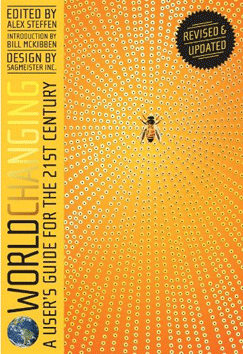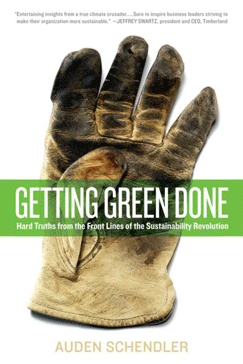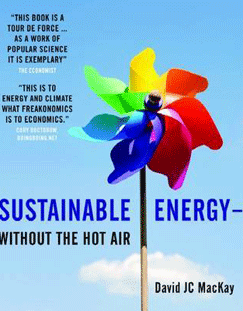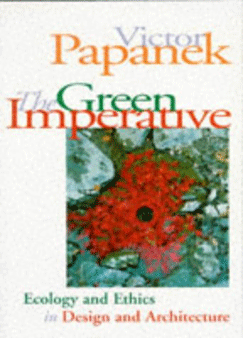With the summer holidays upon us, we look at some books relating to sustainability that you could pack in your travel bag. Or, indeed, take out into the garden

Long before the launch of DEVELOP3D Sustainability I spent over a year reading a wide range of papers, magazines, blogs and, of course, books around the subject.
Maybe due to age or spending hours, as many of us do, glued to an LCD screen all day, I found that the information, concepts, thoughts and opinions I read in a good old fashioned, paper bound book sank in more readily and more deeply.
Also, having talked to many of the contributors to DEVELOP3D Sustainability, now and in future issues, it’s clear that, while digital information is the future, if you really want to dig into a subject then spending a few quid on amazon or searching a bookstore is still a good way to learn more about a subject. And sustainability is no different.
So, with that in mind, I’ll give you the three that have influenced and informed my thinking the most over the last twelve months. Then fellow book worms and sustainability whiz-kids, Dawn Danby and Leyla Acaroglu, recommend a few more and say why.
If you think we have missed a good book that covers the subject of sustainability, please drop us a line and we’ll get a list going to share around.

Worldchanging 2.0
by Alex Steffen

This is it for me; the Holy Grail for those looking to understand the complexities, the often seemingly opposing views and different perspectives on the subject of sustainability. Along with a near cast of thousands, Alex Steffen and the team at Worldchanging.com have put together 600 pages of incredible and diverse material.
Split into several sections, which are further sub divided and contributed to by leaders in their fields, the book ranges from energy, healthcare, activism, politics, food to sustenance and culture. And, of course, there’s a wonderful section on sustainable design.
The hefty tome runs the gamut of anything even vaguely related to making the world a better place. Originally published in 2002, the latest edition adds more detail and new chapters on a huge variety of subjects.
There’s no subtlety when you read the book’s strap line: “A user’s guide for the 21st century.” Believe it. Read it. It’s a rallying call for those that actually want to do something. Designers will need to get increasingly savvy on sustainability. Find out what your client’s sustainability commitments are and push them a little by showing them what their peers and competitors are doing.
If you had to read just one book in this list, I’d highly recommend this one. AD

Powering the Dream
by Alexis Madrigal

Just as I was reading the final chapter to this book, I was also listening to an interview with Mike Watt, legendary punk bassist with the MinuteMen.
In that interview, Watt said “The only thing new is you finding out about it.” There’s some heavy truth to those words when considering the future of energy.
Today, more than ever, there’s a huge focus on more sustainable, cleaner technology as the source for our energy generation. But are these innovations in the truest sense or a continuation of age old ‘technologies’ that have since passed beyond the T word?
Madrigal’s ‘Powering the Dream’ explores this very concept. By travelling into the past of the emergent United States over the last 200 years, he discovers that many of the technologies that we are banking upon have been around for decades, if not centuries and he begs the question: are we headed in the right direction now? It’s fascinating. AD

Getting Green Done
by Auden Schendler

Amongst the many books that relate to sustain- ability, a lot focus predominantly on either the concepts, the theory or an abstract, ideal world. What made Schendler’s work stick for me is that it’s the polar opposite to the theoretical.
Schendler is vice president of sustainability at Aspen Skiing Company and has worked previously in corporate sustainability at the Rocky Mountain Institute.
Beginning with an analogy of trying to convince snow-tractor mechanics to switch to a more ecologically sound, water-based parts washer, he then battles with local groups and also, interestingly, battles internally for a more sustainable way of doing business.
It’s abundantly clear that the road is tough, is often frustrating, but ultimately rewarding.
The key take away from this for me is that for a business to move towards a more sustainable way of working, it needs a mix of both passionate people and a sound business case – one that takes into account financial return as well as minimising core business processes and drivers. AD

Dawn Danby (DD) is the sustainable design program manager at Autodesk. She co-wrote this issue’s Guide to Whole Systems Thinking in Design together with Jeremy Faludi
In the Bubble: Designing in a complex world
by John Thackara

What do we need to design for a world with less stuff and more people? Our world’s demographics and ecological crises demand a differ- ent kind of think- ing, well articulated by John Thackara in his
classic and wonderfully readable In The Bubble (2005).
Most of the sustainable solutions we see emerging in design and engineering are variations on established approaches to efficiency, and the results are often mar- ginal rather than radical. While we find better ways to shave off a bit of material or improve a vehicle’s MPG, approaches like these are well-worn industrial strategies.
They drop in and out of vogue, mirroring cost curves of energy and raw materials.
“We’ve built a technology-focused society that is remarkable on means, but hazy about ends. It’s no longer clear to which question all this stuff – tech – is an answer, or what value it adds to our lives”, writes Thackara. In lieu of focusing on technical solutions, Thackara ties design to modern virtues such as speed, mobility and conviviality.
From the surprising lifecycle of high-speed trains to innovations in mate- rials and sensors, the book’s examples are grounded in a human context, reminding us that the world we’re designing for is social, complex, and in need of better questions before cleverer answers. DD
Sustainable Energy: Without the hot air
by David JC MacKay

A friend recently asked, “Could one solar power array covering 100 square miles parked in the Arizona desert really power the entire United States?” I had an immediate gut response, but it’s more challenging to properly articulate whether this could be both technically possible and a sane idea.
Most of us, public figures included, are monstrously ill-equipped to begin to answer questions like these. Debates on sustainable energy are rife with inaccu- rate apples-to-oranges comparisons and shot through with magical thinking.
Cambridge physics professor David JC MacKay set out to tackle the public’s energy innumeracy in his refreshingly lucid and occasionally hilarious book, ‘Sustainable Energy – Without the Hot Air’.
Seeking to ensure that we’re all using the same numbers, MacKay dives into the technical possibilities and limita- tions of sustainable energy, consciously leaving others to decide what’s economically feasible.
Are mobile phone chargers really at the core of Britain’s energy concerns? “All the energy saved in switching off your charger for one day is used up in one second of car driving”, answers MacKay. He appeals to our reason, reminding us that saving a very small amount of energy in our own lives will simply fail to have a big effect when scaled up.
Seeking to identify the real solutions, the result is a book that maps the domain of modern energy, is a relief from the hype, and acts as an operating manual for those who are engineering and designing the way we use energy in the years to come. DD
(Editor’s Note: You can also download a free PDF version at www.withouthotair.com – though the print version is a much nicer read)
Regular DEVELOP3D Sustainability contributor Leyla Acaroglu (LA) is the founder of Melbourne-based consultancy Eco Innovators
The Green Imperative: Natural Design for the real world
by Victor Papanek

“There can be little doubt that the environment and the ecological bal- ance of the planet are no longer sus- tainable. Unless we learn to preserve and conserve Earth’s resources, and change our most
basic patterns of consumption, manufacturing and recycling, we may have no future” – Papanek.
As a young design student I remember reading through the first few chapters of ‘The Green Imperative’ by Victor Papanek and crying (possibly quite loudly) as I sat in the back of Engineering 101.
The tears were not attributed to beauti- fully written prose or a moving narrative, they were in fact, related to my unfolding realisation of the mighty responsibility that a designer has, not just to the end user of their products but to the entire world and all that exists within it!
Needless to say, this book changed my life. Written in 1995, Papanek’s game- changing book followed on from his successful (and revolutionary) ‘Design for the Real World’ (1984). ‘The Green Imperative’ was one of the first books to put forth the idea of eco-design as not only a possibility but as a core responsibility for all designers.
Papanek passionately believed in the power of design to change the world and he paints a compelling argument for designers to ‘design for need not greed’.
It really is a guidebook for particle eco-design, initiating the now widely used “design for x” strategies. Whilst some of the product examples are outdated – the strategies and approaches for eco-design are still very relevant today.
The book is not just for designers – it also addresses the issue of consumerism and responsibility in manufacturing and business activities. Ideas around the ethical, social and environmental dimensions of production and consumption are explored with solutions such as sharing instead of owning and doing more with less being put forth as viable alternatives to the current earth-destroying trajectory.
Inspiring, confronting, informative and compelling – this book is a must read for all designers. Papanek’s exploration of the issues and opportunities has influenced a generation (this one included) of designers to engage with the notion of eco-design.
I might be biased, but if you create or consume things (which covers most people) then you should stop whatever you’re doing right now and get your hands on a copy of ‘The Green Imperative’. After all, we design the world so we might as well eco-design it! LA
Books on sustainability in time for your summer travels
No
Default






